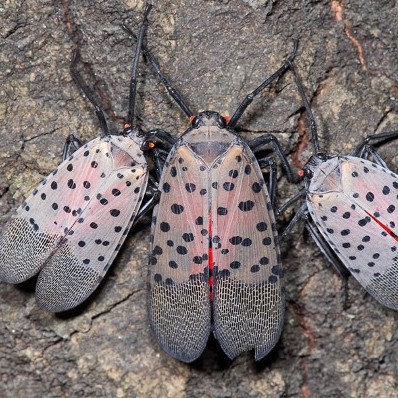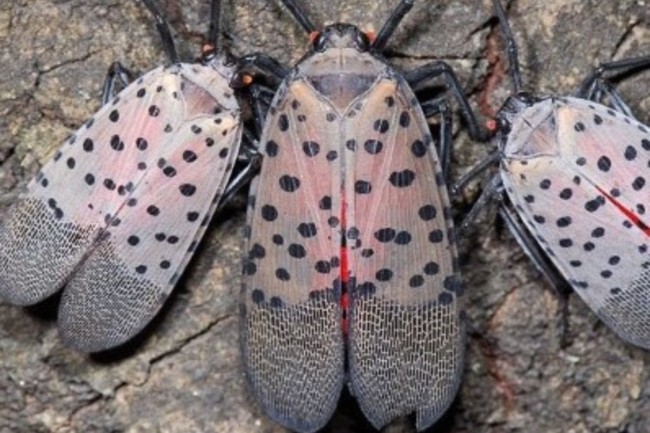Despite their colorful exteriors, the red and black adult spotted lanternfly residents seen throughout Hudson County during the summer months are not welcome visitors. The spotted lanternfly is an invasive insect species that doesn’t hurt humans or animals but is extremely harmful to plants and trees. Given that New Jersey is known as The Garden State for a reason, it’s important to protect both the beauty offered by the state’s abundant flora as well as the agricultural businesses that help the state thrive — which means killing these invasive pests whenever you can.
Though it’s winter and the bugs themselves are normally seen during the summer months, now is the time that spotted lanternflies lay egg masses. Removing and destroying these egg masses when they appear are just as important as killing the bugs themselves. We’ve compiled some tips and tricks to help get rid of these egg masses safely, as well as what to during the winter and summer months when it comes to lanternflies. Read on to learn more about how to deal with spotted lanternflies in New Jersey.

Photo Credit: City of Hoboken via X
About the Spotted Lanternfly
The spotted lanternfly was first reported in 2014 in Pennsylvania. Since then, the bug has been seen throughout the East Coast, including New Jersey. The bugs lay egg masses in the winter, and turn into adults in the summer. They have red wings with black spots, and are about the size of a quarter. Residents who spot the pest are encouraged to both report and kill it.
The spotted lanternfly is a serious invasive pest with a healthy appetite for our plants and it can be a significant nuisance, according to the New Jersey Division of Agriculture, affecting the quality of life and enjoyment of the outdoors.
The spotted lanternfly uses its piercing-sucking mouthpart to feed on sap from over 70 different plant species. It has a strong preference for economically important plants and the feeding damage significantly stresses the plants which can lead to decreased health and, potentially, death. And, let’s be honest, they’re pretty gross to look at.
Read More: Flood Advisory Issued in Hoboken; What to Do if Your Home Floods
What to Do in the Winter
The New Jersey Department of Agriculture has a great deal of information on how to handle the spotted lanternfly, including a month-by-month breakdown of recommended actions based on the bug’s life cycle.
The adult spotted lanternfly does not survive the winter, but the egg masses do. The lanternflies lay eggs from September through December, and egg masses can be seen from September through June — residents are advised to scrape/smash any lanternfly eggs they might see during that time period. The egg masses can be placed permanently in an alcohol solution like rubbing alcohol or hand sanitizer, or scraped into a plastic bag and thrown in the trash. This YouTube video from Penn State University also shows how to destroy the egg masses.
While the egg masses can be found almost anywhere, they are often laid on flat surfaces — including tree bark, rocks, lawn furniture, firewood, boats, RVs, pallets, or anything left outdoors. Freshly laid egg masses have a light gray mud-like substance covering the eggs, while older egg masses have a light tan color resembling cracked mud. Hatched eggs masses do not have a mud-like covering, and look similar to seeeds. Per the New Jersey Department of Agriculture, research has shown that 80 to 90 percent of egg masses on trees are found 10 feet and above from the ground.

Photo Credit: New Jersey Department of Agriculture
The New Jersey Department of Agriculture also conducted studies in 2018 and 2019 on the effects of ovicides — an agent that kills eggs — on spotted lanternfly egg masses. This method provides a safe and environmentally-friendly option, and also helps control egg masses that are not accessible for removal or smashing. The NJDA says that if the egg mass is in a reachable area, smashing or scraping is the most effective option.
The most effective products tested were paraffinic and/or mineral oils such as JMS Stylet oil, Damoil, and Lesco Horticultural oil, which are commonly used in fruit systems as insecticides to control soft-bodied insects and are also available at local garden centers. When oils were applied at a solution of at least three percent, they were effective in killing up to 75 percent of treated eggs. The only plant-based oil, soybean oil, had similar control of egg masses when applied at a 50% concentration.
The NJDA noted that one of the most important parts of making sure this method is effective is to have good coverage and apply the oil solution directly to the egg masses.
What to Do in the Summer
For August and September, residents are advised to destroy any life stage of the insect, up to and including the application of pesticides.
The fastest and most effective way to kill the spotted lanternfly is to quite literally stomp it out. In fact, the NJ Department of Agriculture’s main campaign is called “Stomp It Out.” As satisfying as it may be to squash a few bugs here and there, residents may encounter many bugs at one time. To control a larger number of pests, residents may need to turn to more efficient pest management methods.
Pesticides are very effective, and while they are commonly available, residents who live in densely populated areas might not want to apply chemicals to areas that are shared with other humans, pets, and children. Several impacted townships in New Jersey have shared more natural ways to manage the pests without using chemicals. Several of the recommendations from the Townships of Bordentown, Montgomery, and Princeton are below.
Vinegar
Vinegar kills spotted lanternflies on contact. While vinegar can be diluted, it is most effective when sprayed directly onto the pest, regardless of its life stage. Vinegar may also harm the underlying plant, so be mindful of where you’re spraying.
Heads up: vinegar can also be harmful to bees. When spraying, avoid any flowers or greenery that bees may pollinate. We also recommend spraying in an area with more concrete and fewer plants in general. It’s also best to avoid spraying in large spaces to help minimize the impact on bees. Try to limit this hack to a small group of Lanternflies that are congregated away from greenery.
Insecticidal Soap
A solution of insecticidal soap can be sprayed directly on any life stage of the lanternfly. Applying a mist of the solution where there is evidence of an infestation is an effective way of killing the pests in a wide surface area. Another use of insecticidal soap is to mix it with apple cider vinegar in a jar and place it outdoors near the infested area with the lid off. The pests will be attracted to the solution, which is toxic to them.
Vacuum
It’s almost too easy to be effective, but it is. Use a Shop-Vac or any other type of vacuum to clear an area of the pests. Once they’re in the canister, douse them with soap and water or another natural pesticide to make sure they’re dead.
Soap + Water
A homemade lanternfly spray made of liquid soap and water is another simple way to kill lanternflies. Dawn or related brand dish soap works fine. Combine 1/4 cup liquid soap with a quart of water plus a tablespoon of vegetable oil in a spray bottle. The soapy water will suffocate and kill the bugs.
Neem Oil
Neem oil is a natural fungicide and pesticide derived from the seeds of the Neem tree. It becomes active when lanternfly bugs and other insects ingest the substance. This method takes some time to work, as the neem oil impacts the pests’ ability to feed. They will eventually starve to death. There are many commercially available products that contain Neem oil, or it can be made at home. A simple homemade spotted lanternfly spray recipe is four teaspoons of Neem oil combined with two teaspoons of liquid soap and a gallon of water, poured into a spray bottle. The solution should be sprayed directly onto the pests.
Diatomaceous Earth
Diatomaceous earth (DE) is a naturally occurring substance made from fossilized remains and it looks like white sand. DE is effective as a pest control tool because it dehydrates bugs and insects upon contact with the substance. Since it only harms pests with an exoskeleton, it is not harmful to humans or animals. Be sure to use food-grade DE, and either dust the impacted area with it, or make a spray by combining four tablespoons DE in a gallon of water.
DIY Traps
Soap Trap
Mix dish soap with apple cider vinegar in a jar and stir thoroughly. Open the jar and place it where bugs are spotted, including hanging the open jar in a tree. Many jars can be used to cover a larger area.
Circle Trap
This trap uses netting, a funnel, and a plastic bag to trap the bugs. Start by wrapping netting around the impacted tree and staple the netting to the tree. Attach a funnel to one end of the netting, and attach a plastic bag to the bottom of the netting. This YouTube video shows how to get the device set up. The bugs will crawl up the tree and be led into the funnel. Once the bugs are in the plastic bag, be sure to kill them using soap, water, essential oil, or another insecticide to make sure they’re dead.
Milkweed Bait
Milkweed is a wildflower that attracts spotted lanternflies. Its sap is poisonous to the lanternfly. Ones that don’t die immediately will be slow-moving, making them easier to catch and kill.
See More: 6 Winter Hikes in the NY + NJ Area
Download Squishr, The Lanternfly-Killing + Tracking App
For anyone who loves turning things into a game, this app is for you. Squishr helps make killing lanternflies fun by tracking how many you’ve killed — plus, it lets you record the date, time, and location of Lanternfly spottings so it can share the data with State Departments of Agriculture. This helps contribute to the improvement of Lanternfly research.











